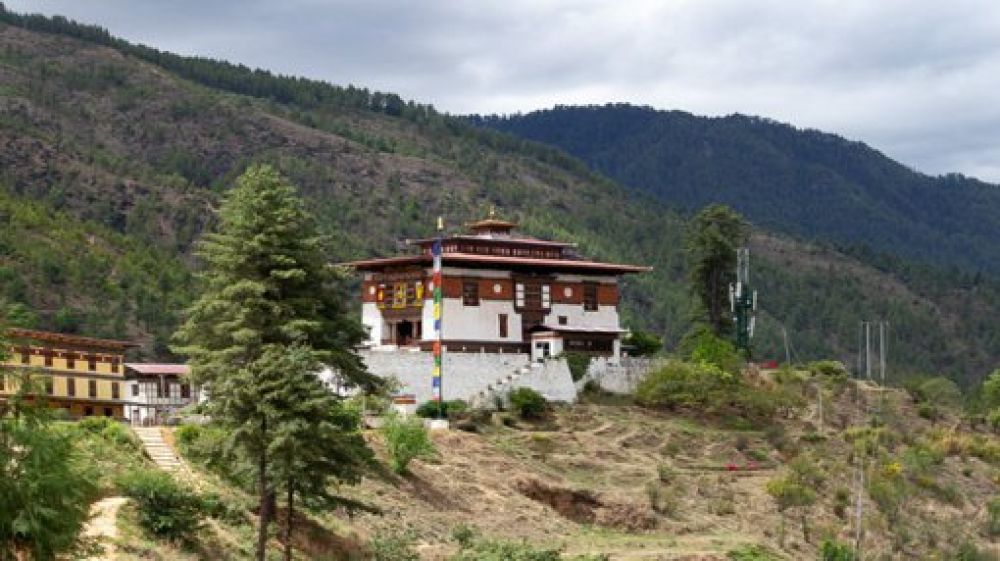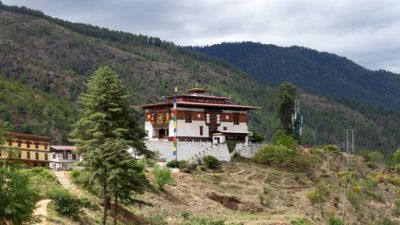

Embark on a serene hike through the lush, forested landscape to the magnificent Tango Monastery, located about 14 kilometers north of Thimphu. This moderate trek leads you on a well-trodden path along the banks of the Wang Chhu River, offering breathtaking vistas of the valley below. The Tango Monastery itself is a splendid example of Bhutanese architectural beauty, with multiple buildings perched on a steep hillside. Visitors will find an array of religious artworks and icons within its walls. The monastery is an important educational institute for monks, so while soaking in the spiritual atmosphere, you may also encounter monks who dedicate their lives to study and meditation. The trek is not just a physical activity; it's a cultural immersion into the heart of Bhutan's spiritual life. Note that appropriate attire is recommended to respect the religious nature of the site.
Simtokha Dzong is a historic fortress located approximately 5 kilometers south of Thimphu. As the oldest dzong in Bhutan, built in 1629, it holds great historical importance and is known as the gateway to the Thimhu valley. The architecture is a stunning example of Bhutanese tradition, with intricate woodwork and slates inscribed with Buddhist teachings. Inside, you'll discover beautifully painted murals and statues that are integral to Bhutanese culture. The dzong currently functions as an institute for language and cultural studies, preserving the country's rich heritage. A tour of Simtokha Dzong offers deep insights into the country's historical narrative and customs. While entrance to the dzong is generally free, hiring a knowledgeable local guide can greatly enhance the experience, as they provide detailed explanations of the dzong's history and significance.
The National Memorial Chorten, standing in the heart of Thimphu, is not only a testament to Bhutanese architectural style but also a focal point for local faith and devotion. Constructed in 1974 to honor the third king of Bhutan, it is a representation of world peace and prosperity. Visitors from all walks of life circle the chorten throughout the day, spinning prayer wheels and offering prayers. The chorten's white-washed walls are crowned with a golden spire, and the interiors are adorned with elaborate mandalas and statues of deities, each symbolic in the Vajrayana Buddhism. You can observe religious ceremonies, listen to the monks' chanting, or simply reflect on the tranquility of the setting. The National Memorial Chorten extends an invitation to experience Bhutanese spiritual practices up close, making it a reflective retreat amidst your travels.
The Weekend Market in Thimphu is a vibrant hub of activity where locals and travellers alike gather to shop and socialize. Located by the banks of the Wang Chhu, the market operates from Friday to Sunday and is an excellent place to explore Bhutanese culture through its culinary delights. Stalls are packed with fresh produce, including vegetables, fruits, grains, and spices indigenous to Bhutan. More than just a place to buy food, the market offers local crafts, textiles, and souvenirs. You can find traditional Bhutanese garments, hand-made jewelry, and religious items among the myriad of products. Navigating the market is an experience in itself as you rub shoulders with the friendly locals, taste exotic flavors, and engage with the bustle of Thimphu's commercial life. Don't miss the chance to try the fiery ema datshi, Bhutan's national dish, at one of the food stalls.
In Bhutan, archery is not just a sport but also a significant part of cultural heritage, with deep roots in the nation's history and mythology. An archery experience in Thimphu provides an extraordinary opportunity to observe, and even participate in, this national sport. Enthusiasts gather at archery ranges to display their skill, strength, and sportsmanship, accompanied by traditional songs and dances to celebrate every hit. The equipment ranges from simple bamboo bows to high-tech versions, and visitors often get a chance to try their hand under the guidance of expert archers. Apart from the chance to learn a new skill, engaging with archery allows you to interact with local people and understand the sport's role in their social life. It's a delightful spectacle whether you're actively participating or just watching from the sidelines.
The Craft Bazaar in Thimphu is a must-visit for anyone interested in Bhutanese arts and crafts. A variety of stalls line the street, displaying an array of authentic Bhutanese handicrafts. Skillful artisans offer their products, ranging from hand-woven textiles and intricate thangkas to bamboo items and earthenware. Each item reflects the craftsmanship passed down through generations, and purchasing them helps support the local economy. The bazaar provides the perfect opportunity to find unique souvenirs while observing the artisans at work. The atmosphere is one of vibrant creativity, where you can immerse yourself in Bhutanese culture and perhaps even try your hand at some crafts with the help of the friendly vendors. As you explore, you'll gain insight into the traditional techniques that make Bhutanese handicrafts so distinguished.
The Bhutan Postal Museum, opened in 2015, might seem like an unconventional attraction, yet it offers a unique perspective on the country's development. Located near the Thimphu Central Post Office, the museum takes you on a journey through Bhutan's communication and postal system history. It showcases rare stamps, some featuring the nation's innovative and unusual designs, which have become highly collectible worldwide. The exhibits not only feature philately but also narrate stories of Bhutan's progress over the decades. A popular highlight is the opportunity to create your own personalized stamp with an image of your choosing – a unique souvenir to take back home. The tour is enlightening and enjoyable for both stamp enthusiasts and casual visitors looking to learn more about Bhutan's culture and society.
The Institute for Zorig Chusum, commonly known as the 'Painting School,' is where students undergo training to master Bhutan's traditional arts and crafts, known as the 13 Traditional Arts. By touring the school, visitors can witness the meticulous process behind Bhutanese art forms such as thangka painting, wood carving, and sculpture. The institute is a testament to the country's commitment to preserving its cultural heritage. Students spend years perfecting their craft under the tutelage of master craftsmen. The tour offers insight into the rigorous training involved and the stunning intricacy of Bhutanese art. Watching these young artists at work is a humbling and inspirational experience, showcasing the talent and dedication required to keep traditional techniques alive. Artworks are often available for purchase, providing support for the institution and its students.
For those seeking to immerse themselves in the natural beauty of Bhutan, the Druk Path Trek is an ideal choice. This moderately challenging trek connects the valleys of Paro and Thimphu, offering stunning views of Himalayan landscapes, pristine lakes, and ancient lhakhangs (temples). The Druk Path Trek can be completed within 4 to 6 days, making it a popular choice for those who want to experience high altitude trekking without committing to a longer duration. Along the way, trekkers encounter diverse flora and fauna, as well as yak herders' camps in remote mountain areas. The trek includes a visit to the famous Taktsang Monastery, perched on a cliffside, which is one of the highlights of any trip to Bhutan. While challenging, the sense of achievement and the breathtaking views make this trek an unforgettable adventure.
The Textile Museum in Thimphu is dedicated to the art of Bhutanese weaving, one of the kingdom's most highly regarded crafts. Opened in 2001, the museum showcases the intricate techniques, patterns, and types of textiles produced across the country. Visitors can observe various weaving styles, learn about the symbolism behind the designs, and understand the role textiles play in Bhutanese culture. From the royal ghos (traditional attire for men) to kiras (traditional attire for women), the museum offers an exceptional display of historical and contemporary textiles, some belonging to the royal family. Special exhibitions might feature themes like textile production processes or ceremonial garments. The museum visit is educational and provides appreciation for the country's textile heritage, considered among the most advanced in the Himalayas.
